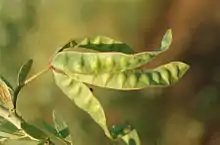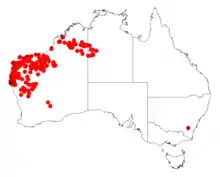Acacia synchronicia
Acacia synchronicia, commonly known as bardi bush,[1] is a shrub or tree of the genus Acacia and the subgenus Phyllodineae endemic to Australia.
| Acacia synchronicia | |
|---|---|
 | |
| Scientific classification | |
| Kingdom: | Plantae |
| Clade: | Tracheophytes |
| Clade: | Angiosperms |
| Clade: | Eudicots |
| Clade: | Rosids |
| Order: | Fabales |
| Family: | Fabaceae |
| Clade: | Mimosoideae |
| Genus: | Acacia |
| Species: | A. synchronicia |
| Binomial name | |
| Acacia synchronicia | |
 | |
| Occurrence data from AVH | |
Description
The spreading spinescent shrub or tree typically grows to a height of 1.5 to 4 metres (5 to 13 ft)[2] but can be as high as 6 m (20 ft). It has an openly branched habit with one or many main stems arising from the base. The grey bark is longitudinally fissured at the base of the main stems and is smoother on the upper branches and can be bronze through to yellowish orange or green in colour.[1] It blooms from August to December and produces yellow flowers.[2]
Taxonomy
The species was first formally described by the botanist Bruce Maslin in 1992 as part of the work Acacia Miscellany 6. Review of Acacia victoriae and related species (Leguminosae: Mimosoideae: Section Phyllodineae) as published in the journal Nuytsia. It was reclassified by Leslie Pedley in 2003 as Racosperma synchronicium then transferred back to the genus Acacia in 2007.[3]
Distribution
It has a scattered distribution in the Kimberley, Pilbara, Mid West and Goldfields-Esperance regions of Western Australia extending into western parts of the Northern Territory where it is often found on alluvial flats, in depressions, on stony plains and along watercourses growing in rocky sand, clay or loam soils around areas of limestone or quartz.[2]
See also
References
- "Acacia synchronicia". Wattle of the Pilbara. Department of Environment and Conservation. 2010. Retrieved 6 October 2018.
- "Acacia synchronicia". FloraBase. Western Australian Government Department of Parks and Wildlife.
- "Acacia synchronicia Maslin". Atlas of Living Australia. Global Biodiversity Information Facility. Retrieved 6 October 2018.